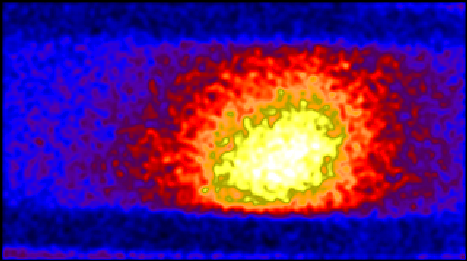Explanation: As the Sun floods Comet Hyakutake with ultraviolet light gases in the coma scatter the radiation and fluoresce making the comet a bright source in the ultraviolet sky. The above image made using data from NASA's Extreme UltraViolet Explorer (EUVE) satellite, represents the intensity of the comet in this invisible high energy band in false color. The image is about 3/4 of a degree high and 2 degress wide and offers insights to the composition of this visitor from the distant solar system that can be obtained from the highest energy bands of the ultraviolet spectrum. The International Ultraviolet Explorer (IUE) satellite has also examined ultraviolet light from the comet and now reports the detection of many bands of molecular emission particularly those due to molecular carbon (C2), carbon monoxide (CO) and caron dioxide (C02) ions as well as indications of a rapid increase in the production of water (H20).
Latest Comet Hyakutake images:
JPL,
Fayetteville
Observer-Times,
NASA's Night of
the Comet,
ICSTARS,
Crni Vrh Obs.,
Cent. Mich U.
1999 2000 2001 2002 2003 2004 2005 2006 2007 2008 2009 2010 2011 2012 2013 2014 2015 2016 2017 2018 2019 2020 2021 2022 2023 2024 2025 |
Yanvar' Fevral' Mart Aprel' Mai Iyun' Iyul' Avgust Sentyabr' Oktyabr' Noyabr' Dekabr' |
NASA Web Site Statements, Warnings, and Disclaimers
NASA Official: Jay Norris. Specific rights apply.
A service of: LHEA at NASA / GSFC
& Michigan Tech. U.
|
Publikacii s klyuchevymi slovami:
comet - euve - ultraviolet - Ul'trafioletovoe izluchenie - kometa Hiyakutake - komety - koma
Publikacii so slovami: comet - euve - ultraviolet - Ul'trafioletovoe izluchenie - kometa Hiyakutake - komety - koma | |
Sm. takzhe:
Vse publikacii na tu zhe temu >> | |
